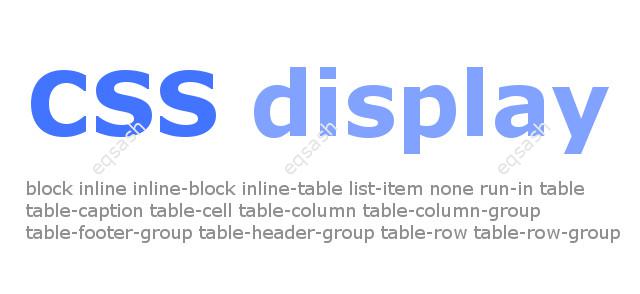Full list of CSS display property values with description

When coding site pages, there is often a need to change the display style of an element, for this styles correctly in CSS there is a display property. It allows you to turn an inline element into a block element and vice versa, which can be useful in different situations. In addition, a property can be used to remove an element from a page, or to give an element various other properties. Below is a complete list of display property values that can be used to control the display style of an element on a page.
At the beginning, it should be said that all values are grouped into several categories:
- global values - the group contains general values;
- display-outside - values from this group determine the external display type of the element;
- display-inside - values determine the internal display type of the element;
- display-listitem - values show the item as a list;
- display-internal - the group contains internal values that can be applied to elements;
- display-box - the group contains general values that can be applied to elements;
- display-legacy - values from this group contain several different values at once.
So, what values does the display property have ? They will be listed below by group. It is important to remember that currently you should specify a single value, although the latest specifications do allow for some values to be combined, this is not yet supported by all browsers. A complete list of possible values will be provided with descriptions for those values that are most in demand.
Group of global values :
The display-outside group has the following meanings:
The display-inside group has the following meanings:
The group display-listitem has the main value list-item , the rest of the values are possible combinations of other values:
The display-internal group has the following meanings:
The display-box group has the following meanings:
The display-legacy group has the following meanings:
There are also values that are included in two groups at once - display-outside and display-inside :
As you can see, there are a lot of values, some of them are completely new. The values none and block are very often used. For example, you can use JavaScript to control the display of an element - hide it or show it using these two values. You may also notice the frequent use of the table-cell value for blocks, it is used so that make vertical alignment in div using another property - vertical-align : middle . It is important to understand that browsers may not support all values for the display property. Most browser supported values are block, inline, list-item, none . Therefore, before using this property and the selected value, you should test the value in all popular browsers.
Latest articles
- 03.04.24IT / Уроки PHP Уроки простыми словами. Урок 3. Все операторы PHP с примерами, с выводом работы кода на экран.
- 02.04.24IT / Уроки PHP Уроки простыми словами. Урок 2. Типы данных в PHP с примерами.
- 02.04.24IT / Уроки PHP Уроки простыми словами. Урок 1. Коротко о языке веб-программирования PHP. Основы синтаксиса.
- 09.11.23IT / Database Errors when migrating from MySQL 5.6 to 5.7 and how to fix them - database dump import failed with an error or INSERT does not work. Disabling STRICT_TRANS_TABLES strict mode or using IGNORE
- 08.07.22IT / Misc Convert office files DOC, DOCX, DOCM, RTF to DOCX, DOCM, DOC, RTF, PDF, HTML, XML, TXT formats without loss and markup changes
 12351
12351